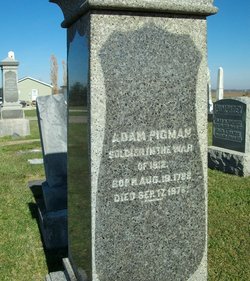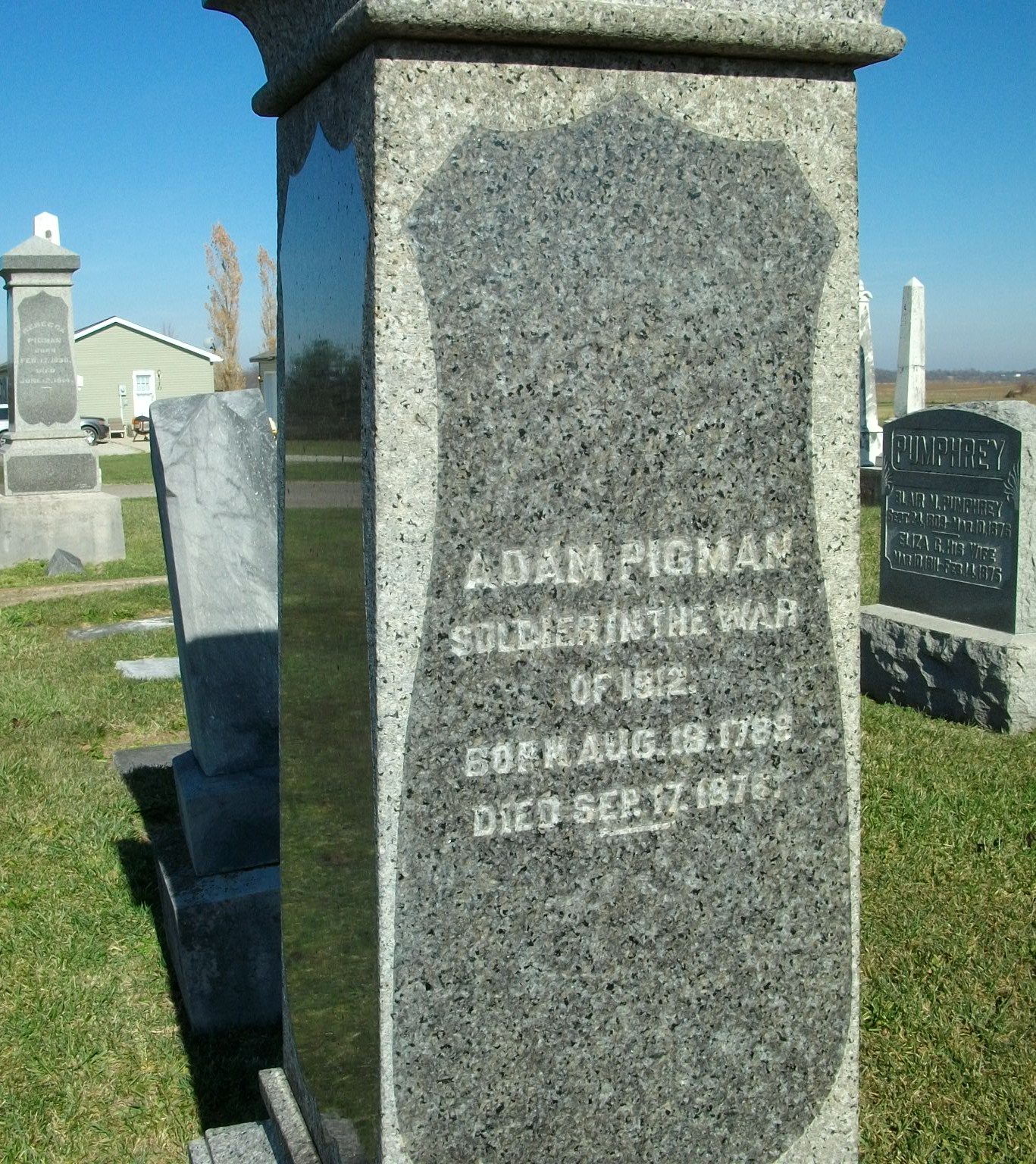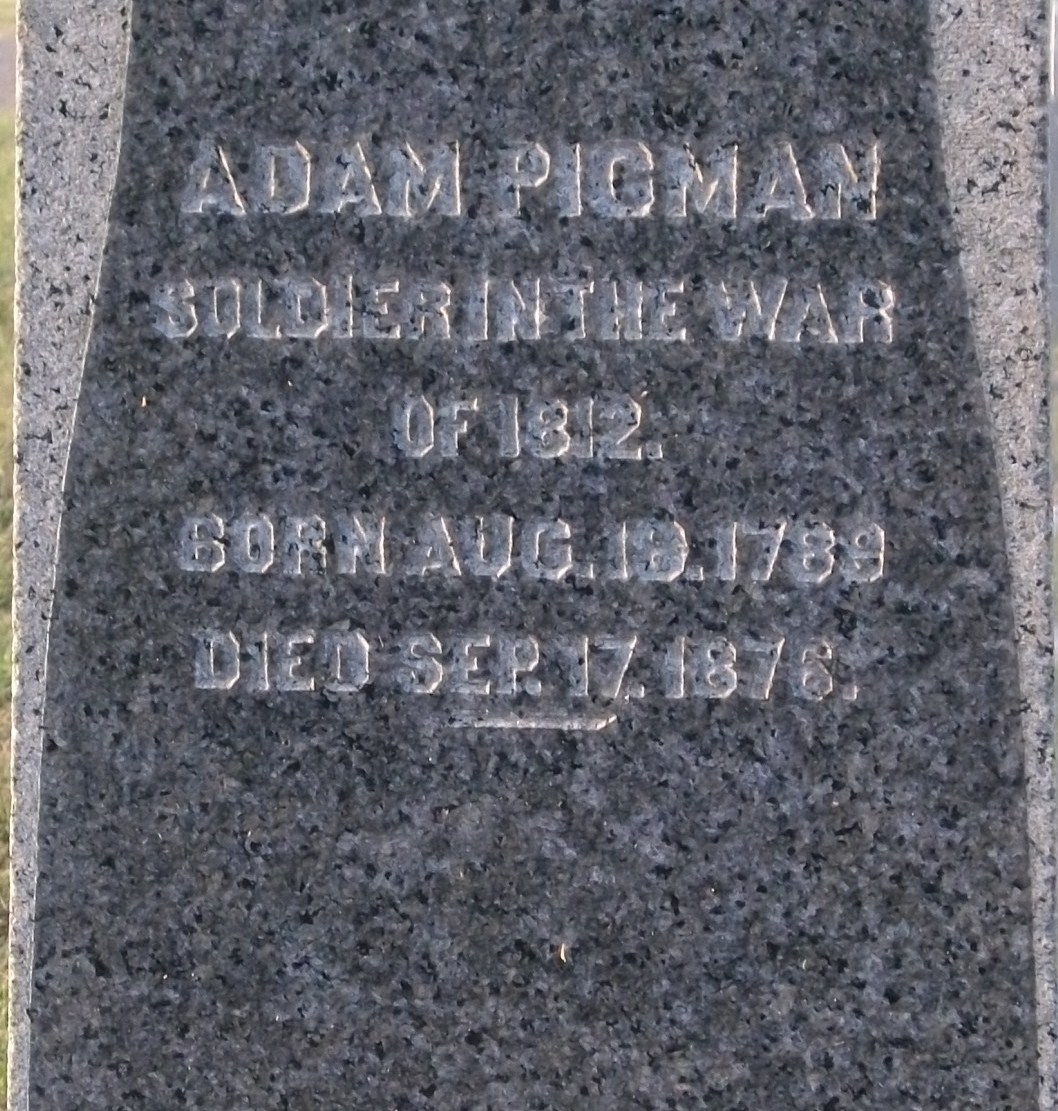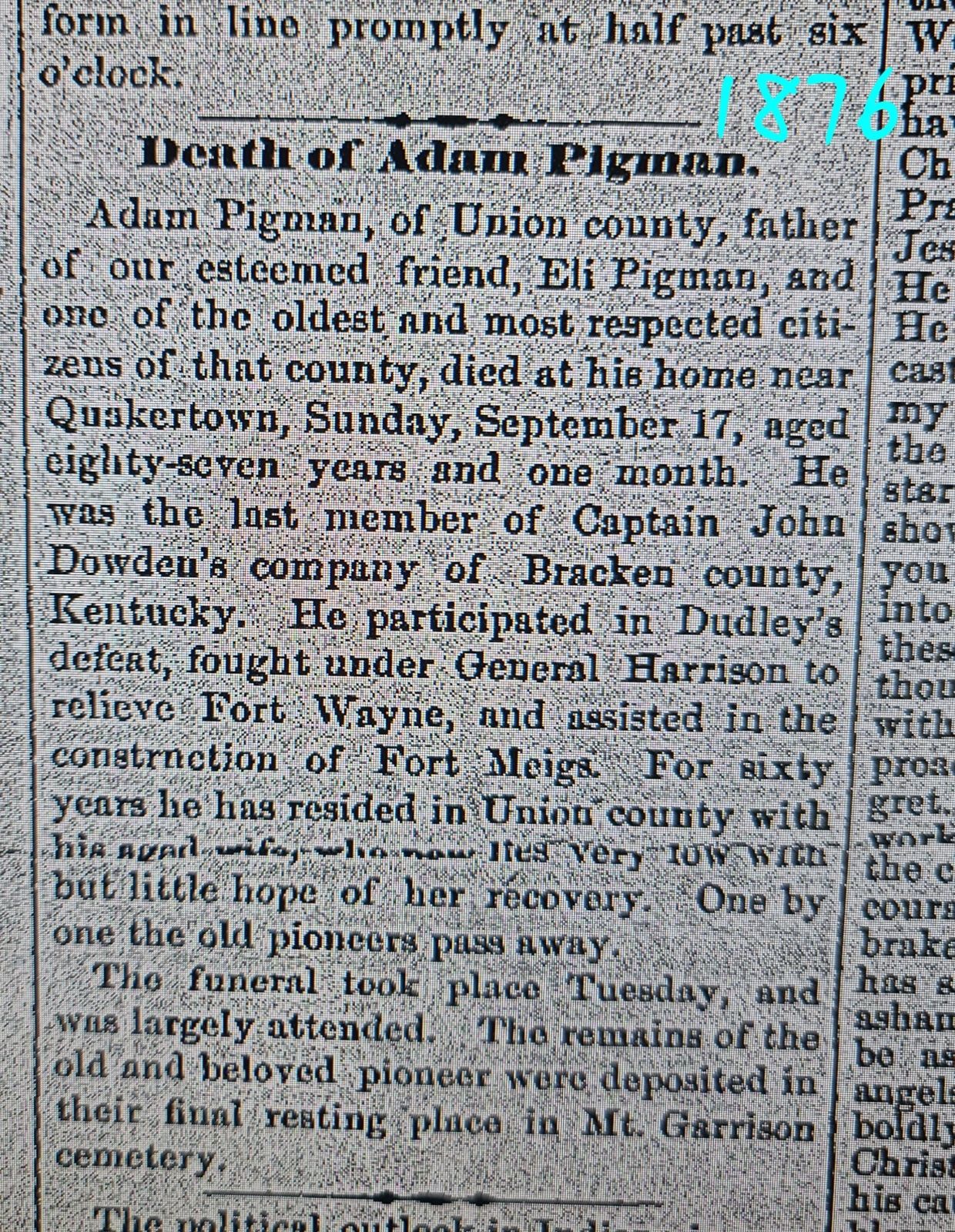Appeared in the Times 7 October 1876
Died On Sunday, September 17, 1876 at his residence in Harmony Township, Union County, Indiana Adam Pigman in the 87 year of his age.
Also, on Saturday, September 23rd, 1876, Mrs. Mary Pigman, wife of Adam Pigman, aged nearly 80 years.
Adam Pigman was born August 18, 1780 in Green County, Pennsylvania. At the age of one year he was taken by his parents to Bracken County, Kentucky, living some time in Fort Augusta, Bracken County. At the age of four years his parents moved to Jessamine County, where he grew to manhood, spending most of his time working at the carpenter's trade. When a boy he often saw those old pioneers of Kentucky, Boone and Kenton, and was a nephew to James Harrod, who built the first cabin on the historic dark and bloody grounds.
Twenty-three years of his life had come and gone, had flown on and out with the even current of events transpiring around him, when the troubled days of 1812 had settled like a dark pall upon our young nation. When the mother country had called to her assistance the wild and save hordes of the wilderness, when the first note of alarm was sounded, when the first call to arms was made, in the early dawn of that day whose history is written in fire and blood, we find him with love of country more than life, going forth in her defense.
He enlisted in the army under Captain Dowden, Colonel Pogue's regiment, serving as fourth Sergeant of his company, and in August of the same year his regiment marched for the seat of war. He was in the relief sent to Fort Wayne, which place they entered without firing a gun. Then they marched to the support of General Winchester in Ohio, following the defeated British and Indians under Proctor down the Maumee River for several days and nights. He was then detailed to help Fort Amanda on the Auglaize river and then afterwards in the relief sent to General Winchester then at Frenchtown on the river Raisin, but was too late to participate in that bloody engagement that clothed Kentucky and Ohio in mourning.
His command then marched to, and helped build Fort Megs, when, after considerable scouting, skirmishing, and enduring many hardships known only to frontier life, in all of which he considered death preferable to dishonor. He was mustered out of the service and returned with a number of his comrades in arms to his boyhood home in old Kentucky, where he again entered the military service, this time as Lieutenant of his company.
He came to Indiana territory, December 1813, and entered a quarter section of land situated within the present boundaries of Fayette county, and in the summer of the next year in company with the Huff family, started again for the far west, traveling through the wilderness on foot, driving stock for his board, They arrived at the destination, now known as Riggor's Mill, in September, 1814. His first work in the new country was to build a house with Huff hewing the timer, including the studding, braces and rafters. It was the first fame house built within the limits of Union County. After the completion of this job he went to Brookville, then composed of a few small cabins, and worked as journey carpenter with Thomas Coldscott, and through this means obtained the money to pay out for his land. From this time the lives of Adam Pigman and Mary (Eli) Pigman flow on in one continuous, ceaseless current to the day of his death.
In December, the same year of their marriage, they moved to their land in Fayette, and on the night of their arrival snow fell to the depth of two feet, and lay on the ground until the next spring, yet, notwithstanding this and many privation incident to new settlers, by the middle of May, they had cleared six acres of ground and had it planted and corn and by the next spring they had cleared in the same way twelve acres more, part of which they planted in fruit trees, being the first planted in the Village Creek Valley. For nine years they lived here and their dwelling though rude had an inviting and friendly look and often as the blaze from the ample fireplace filled the low room with a mellow light, could be heard the hum of the spinning wheel and the click of the loom. They didn't that to begin their struggle in life together where their parents left off, but were content to begin at the beginning and work until they had earned luxury and ease before they enjoyed it. Sometimes they suffered for the comforts of life, yet they always cheerfully submitted to any privation or labor that feel to their lot.
On November 4, 1875 with a large assembly of their relatives and friends these old people celebrated the sixtieth anniversary of their wedding. It was a time of more than ordinary interest, rich with memories that came like golden echoes from the shore of the past. The biographer of that occasion speaking of the early life, trials and tribulations of these veteran pioneers writes as follows:
"They can remember the time when the picturesque hills and valleys of Eli's creek now dotted with cultivated by husbandry, were covered with an unbroken forest, in which the Indian roamed at will, hunting and fishing. They could see across the boundary of the Indian Territory in the home in which they were married. They can remember the time when the pioneers first began to make an inroad into this wilderness, blazing the way by patient toll and persistent industry for the civilization of the present. They remember the time when men were baptized as it were with fire, and when mutual interest and a common danger led them to associate together as brother and sister tolling for the same end. They remember how step by step, they conquered the privations incident to the life of the early settler, until at last they secured a well-earned competence for their old age. The early settlers of this part of the county were men and women who had graduated in the school of patience, and were endured to privations, hardship and toil, such as has not been known by the thronging multitudes that followed them."
Carding and spinning mills were unknown and the clothing for the family was manufactured at home. Carding, spinning, weaving and making the garments for the family were all done by hand, and the cooking at an open fireplace without the convenience of the present day. Fields were to be cleared in the green timber, roads to be cut through the trackless forest, schoolhouse and churches were to be built; a means of defense was to be kept organized in all of which they contributed their full share of means and time, he serving as captain of a company of territorial militia for several years.
But in the history of these old people., so briefly sketched, we have to pass, for the sake of brevity, a hundred incidents of the good old-fashioned times directly connected with the early settling of the White Water Valley, incidents that would be vastly suggestive to many of our citizens, recalling the stirring events of pioneer life and reviving the recollection of circumstances and facts more than a century ago.
How peculiarly fitting it was that hearts so long and intimately blended should almost simultaneously cease to throb and forever rest from their labors. Only six short days were they separated where together their youth was resumed in the land of the immortals. The funeral services observed the one on Tuesday the 19th and the other on Sunday, the 24th, were the spontaneous expressions of respect and admiration from a community with whom for over half a century their lives have been cast and by whom they were venerated as patriarchs. Rev. W. O. Brooks, of Zanesville, Ohio officiated as the former and Elder George Harlan, said to be the oldest ordained minister in the White Water Valley at the latter. Both services were conducted at the Mt. Garrison M. E. church and were perhaps the largest funeral ever witnessed in Union County. Over 800 vehicles were at the former and we were told nearly as many were at the latter. Side by side in the Mt. Garrison graveyard rest the remains of these venerable pioneers. May they rest in Peace J.A.M.
Appeared in the Times 7 October 1876
Died On Sunday, September 17, 1876 at his residence in Harmony Township, Union County, Indiana Adam Pigman in the 87 year of his age.
Also, on Saturday, September 23rd, 1876, Mrs. Mary Pigman, wife of Adam Pigman, aged nearly 80 years.
Adam Pigman was born August 18, 1780 in Green County, Pennsylvania. At the age of one year he was taken by his parents to Bracken County, Kentucky, living some time in Fort Augusta, Bracken County. At the age of four years his parents moved to Jessamine County, where he grew to manhood, spending most of his time working at the carpenter's trade. When a boy he often saw those old pioneers of Kentucky, Boone and Kenton, and was a nephew to James Harrod, who built the first cabin on the historic dark and bloody grounds.
Twenty-three years of his life had come and gone, had flown on and out with the even current of events transpiring around him, when the troubled days of 1812 had settled like a dark pall upon our young nation. When the mother country had called to her assistance the wild and save hordes of the wilderness, when the first note of alarm was sounded, when the first call to arms was made, in the early dawn of that day whose history is written in fire and blood, we find him with love of country more than life, going forth in her defense.
He enlisted in the army under Captain Dowden, Colonel Pogue's regiment, serving as fourth Sergeant of his company, and in August of the same year his regiment marched for the seat of war. He was in the relief sent to Fort Wayne, which place they entered without firing a gun. Then they marched to the support of General Winchester in Ohio, following the defeated British and Indians under Proctor down the Maumee River for several days and nights. He was then detailed to help Fort Amanda on the Auglaize river and then afterwards in the relief sent to General Winchester then at Frenchtown on the river Raisin, but was too late to participate in that bloody engagement that clothed Kentucky and Ohio in mourning.
His command then marched to, and helped build Fort Megs, when, after considerable scouting, skirmishing, and enduring many hardships known only to frontier life, in all of which he considered death preferable to dishonor. He was mustered out of the service and returned with a number of his comrades in arms to his boyhood home in old Kentucky, where he again entered the military service, this time as Lieutenant of his company.
He came to Indiana territory, December 1813, and entered a quarter section of land situated within the present boundaries of Fayette county, and in the summer of the next year in company with the Huff family, started again for the far west, traveling through the wilderness on foot, driving stock for his board, They arrived at the destination, now known as Riggor's Mill, in September, 1814. His first work in the new country was to build a house with Huff hewing the timer, including the studding, braces and rafters. It was the first fame house built within the limits of Union County. After the completion of this job he went to Brookville, then composed of a few small cabins, and worked as journey carpenter with Thomas Coldscott, and through this means obtained the money to pay out for his land. From this time the lives of Adam Pigman and Mary (Eli) Pigman flow on in one continuous, ceaseless current to the day of his death.
In December, the same year of their marriage, they moved to their land in Fayette, and on the night of their arrival snow fell to the depth of two feet, and lay on the ground until the next spring, yet, notwithstanding this and many privation incident to new settlers, by the middle of May, they had cleared six acres of ground and had it planted and corn and by the next spring they had cleared in the same way twelve acres more, part of which they planted in fruit trees, being the first planted in the Village Creek Valley. For nine years they lived here and their dwelling though rude had an inviting and friendly look and often as the blaze from the ample fireplace filled the low room with a mellow light, could be heard the hum of the spinning wheel and the click of the loom. They didn't that to begin their struggle in life together where their parents left off, but were content to begin at the beginning and work until they had earned luxury and ease before they enjoyed it. Sometimes they suffered for the comforts of life, yet they always cheerfully submitted to any privation or labor that feel to their lot.
On November 4, 1875 with a large assembly of their relatives and friends these old people celebrated the sixtieth anniversary of their wedding. It was a time of more than ordinary interest, rich with memories that came like golden echoes from the shore of the past. The biographer of that occasion speaking of the early life, trials and tribulations of these veteran pioneers writes as follows:
"They can remember the time when the picturesque hills and valleys of Eli's creek now dotted with cultivated by husbandry, were covered with an unbroken forest, in which the Indian roamed at will, hunting and fishing. They could see across the boundary of the Indian Territory in the home in which they were married. They can remember the time when the pioneers first began to make an inroad into this wilderness, blazing the way by patient toll and persistent industry for the civilization of the present. They remember the time when men were baptized as it were with fire, and when mutual interest and a common danger led them to associate together as brother and sister tolling for the same end. They remember how step by step, they conquered the privations incident to the life of the early settler, until at last they secured a well-earned competence for their old age. The early settlers of this part of the county were men and women who had graduated in the school of patience, and were endured to privations, hardship and toil, such as has not been known by the thronging multitudes that followed them."
Carding and spinning mills were unknown and the clothing for the family was manufactured at home. Carding, spinning, weaving and making the garments for the family were all done by hand, and the cooking at an open fireplace without the convenience of the present day. Fields were to be cleared in the green timber, roads to be cut through the trackless forest, schoolhouse and churches were to be built; a means of defense was to be kept organized in all of which they contributed their full share of means and time, he serving as captain of a company of territorial militia for several years.
But in the history of these old people., so briefly sketched, we have to pass, for the sake of brevity, a hundred incidents of the good old-fashioned times directly connected with the early settling of the White Water Valley, incidents that would be vastly suggestive to many of our citizens, recalling the stirring events of pioneer life and reviving the recollection of circumstances and facts more than a century ago.
How peculiarly fitting it was that hearts so long and intimately blended should almost simultaneously cease to throb and forever rest from their labors. Only six short days were they separated where together their youth was resumed in the land of the immortals. The funeral services observed the one on Tuesday the 19th and the other on Sunday, the 24th, were the spontaneous expressions of respect and admiration from a community with whom for over half a century their lives have been cast and by whom they were venerated as patriarchs. Rev. W. O. Brooks, of Zanesville, Ohio officiated as the former and Elder George Harlan, said to be the oldest ordained minister in the White Water Valley at the latter. Both services were conducted at the Mt. Garrison M. E. church and were perhaps the largest funeral ever witnessed in Union County. Over 800 vehicles were at the former and we were told nearly as many were at the latter. Side by side in the Mt. Garrison graveyard rest the remains of these venerable pioneers. May they rest in Peace J.A.M.
Family Members
Advertisement
Explore more
Sponsored by Ancestry
Advertisement
















